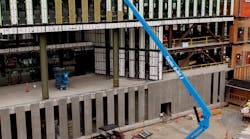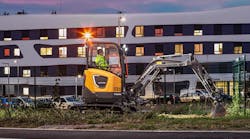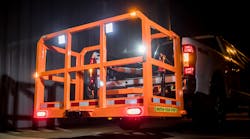JLG, Kubota Tractor and Skyjack Top 2023 Innovative Product Awards
As always, RER’s annual Innovative Product Awards feature some unusual surprises and this year is no exception. Voted on by RER’s panel of guest judges from the rental industry, JLG and Skyjack solve problems on construction jobsites , and Kubota takes compactness to a new level with almost zero overhang and an uncanny ability to work in tight spaces.
Category winners were:
Compressors/Air Tools: Apeiron Energy’s Aquaculture Aeration System
Computer Software: Point of Rentals’ Public API
Earthmoving: Kubota Tractor’s U10-5 minimal tail swing excavator (also Silver Winner)
Engines/Power Sourcing: Apeiron Energy’s Power Cube
Lifts: JLG’s 670SJ Self-Leveling Chassis Boom Lift (also Gold Winner)
Material Handling: JLG’s Rotating Telehandlers
Miscellaneous: DryAir Manufacturing Co.’s 1800 Hydro Heat Pro
Technology Enhancements: Trackunit’s Kin and JLG’s Next Generation Augmented Reality App
A Level Aerial Playing Field
AWARD: GOLD
Product: 670SJ Self-Leveling Chassis Boom Lift
Manufacturer: JLG Industries
Key Innovation: Equipped with JLG’s exclusive and patented self-leveling technology, the 670SJ is engineered to automatically adapt to terrain on slopes up to 10 degrees in any direction, while driving with full functionality at a class-leading 67-foot platform height.
Manufacturer’s description:
The 670SJ’s self-leveling technology is designed to adjust the boom lift’s chassis to the ground conditions — rather than having to adjust the ground conditions to the machine. This allows the 670SJ to navigate uneven terrain while driving at height from one job to the other without lowering the boom, leading to significant productivity gains throughout the workday. All of these features are made possible through the machine’s advanced control system. This system continuously receives performance data from various sensors on the machine, then displays the information through a digital display and selectable screen interface in the platform during operation, ensuring users are more knowledgeable about what’s going on at ground level while working at height.
JLG’s self-leveling technology offers a host of benefits for machine operators and their support crews, including reducing (and in some cases even eliminating) the prep work required to level the work area. That means no more pre-grading the site or constructing laborious cribbing before getting to work. It also eliminates the trial and effort of repositioning a boom lift to find a level work area. This helps operators get into position and up to the work area quicker, maximizes reach capabilities and reduces the need for larger, higher-reaching lifts onsite as a backup for added reach when uneven ground conditions exist. Operator comfort and safety were also key factors in the development of this product. The 670SJ provides a smoother ride as operators travel across a job site thanks to its advanced control system. It is designed to continuously adjust to the terrain to keep the platform level and minimize movement, thereby reducing operator fatigue, as well as the potential for objects to bounce around and/or out of the platform.
RER Commentary:
When a contractor surveys a jobsite, where he or his staff is going to work, he takes notices of slopes or inclines where the terrain might be uneven in what will be his working area. He may need to figure out a way to even out the terrain or how he might need to maneuver a boom lift to get proximity to the building where he may be working. That has been the reality when contractor or machine operators survey the area where they need to work.
But what if the terrain or slope didn’t have to be changed or what if the worker didn’t have to look for a different point of access to a building because the mobile elevating work platform itself could correct the angle by changing itself? What if you could adjust the machine to the ground conditions, rather than try to alter the ground conditions to accommodate the machine? As one of our judges says, that would be a major shift in equipment development and jobsite safety, and it has arrived.
The 670SJ Self-Leveling Chassis Boom Lift represents the beginning of a solution to problems that contractors have faced as long as MEWPs have lifted people and materials into the air, the fact that in some cases conditions on the ground make it impossible for the aerial unit to function. The 670SJ won’t solve every jobsite access issue, but it will provide a solution in many cases.
“It’s an automatic leveling capability where it has four control arms that work in order to be able to provide the configurations to maintain a level platform, a level boom, a level counterweight, everything independently level and close to the ground,” explains Nate Hoover, JLG director of marketing and product management.
Hoover says the inspiration for the 670SJ came from customers. Customers explained that they had to contend with the environment and terrain on jobs they had to do on any given day. “One of the points we continually heard from customers is ‘We have to continuously re-position this machine because we need to keep that level down in order to stay within the operating incline,’” Hoover notes. “The other thing they say is, ‘If we can’t find a spot. we have to put something beneath a tire,’ which is cribbing, and not acceptable within the industry.”
Customers would also say they’d end up moving to a more difficult location because it was somewhat level and try to get to the location where they had to work. “Sometimes they have to upgrade to a larger boom,” Hoover says. “Other times they have to be in a location where they have to slow traffic down and there’s a lot of sub-optimized conditions. And these things that we heard really drove that inspiration of being able to deliver this type of solution.”
In essence, the self-leveling boom solves:
- Constant repositioning
- Removing small areas of earth with a compact loader to level the ground
- Using a longer boom lift to reach the work area from a level spot beyond where operators would ideally like to place the machine
- Using multiple boom lifts where only one would do the job
- Cribbing the machine on a localized platform to attain a level work surface
- Shoring up the ground or stone leveling a raceway to attain a level work surface.
The unit can be driven at full height and automatically levels as it drives. If the machine is about to exceed the 10-degree incline a warning message is flashed to the operator and if it exceeds the allowed operating incline, the unit will stop. The operator will have to descend to be able to maneuver over a steeper incline to get to a place within the accepted operating incline for driving or working.
The 670 SJ’s self-leveling capability is a significant safety enhancement, JLG says. “It allows the operator to remain more attentive, it enhances the attentiveness of the operator to the surrounding regions including the terrain because they don’t have to focus on trying to maintain the posture and position inside the platform at all times,” says Hoover. “In a traditional machine, more often than not, [the operator is] holding on and trying to maintain some type of awareness of both the controls as well as the terrain because at any moment they might be shifting forward or backward. But because it is actively self-leveling that’s no longer a concern, they no longer feel like they have to stay semi-rigid in the platform. They can now look at their surroundings and concentrate on their environmental awareness while driving as opposed to concentrating on their physiological body position while they’re in the platform.”
Hoover sums up the value of the 670SJ Self-Leveling Chassis Boom Lift this way. “I think the most important three points that I would drive home is it enhances productivity, safety and operator comfort,” says Hoover. “That’s what it really delivers. How it delivers that obviously is important as well, but it provides confidence to an operator to improve productivity and enhance that jobsite.”
@@@@@@@@@@@@@@@@@@@@@@@@@@@@@@@@@@@@@@@@@@@@@@@@@@@@@@@@@@@@@@@@@@@@@@@@@@@@@@@@@@@@@@@@@@@@@@@@@@@@@@@@@@@@@@@@@@@@@@@@@@@@@@@@@@@@@@@@@@@@@@@@@@@@@@@@@@@@
Skinny is Good
AWARD: SILVER
Product: U10-5 minimal tail swing excavator
Manufacturer: Kubota Tractor
Key Innovation: The U10-5 is Kubota’s answer to the rental or professional customer, for example, who requires a compact excavator in the 0- to 1-ton range, but in a more compact frame with minimal tail swing to be more nimble and agile than ever before for both residential and commercial work. The U10-5 provides superior flexibility when working in tight spaces with very minimal overhang at 0.6 of an inch over the tracks, ensuring excellent balance, stability, and fast operation. It truly is the ideal model for working in compact spaces.
Manufacturer’s Description: Kubota announced a new addition to its robust excavator lineup: the all-new U10-5 minimal tail swing excavator, taking an in-demand spot in the U Series minimal tail swing lineup. The U10-5 contracts to 2 feet, 6 inches, then when the operator wants to widen the tracks, the tracks widen out to 3 foot, 3 inches. The U10-5 is Kubota’s answer to the rental or professional customer who requires a compact excavator in the 0- to 1-ton range. With a more compact frame and minimal tail swing, the U10-5 provides superior flexibility when working in tight spaces with very minimal overhang at 0.6 of an inch over the tracks, ensuring excellent balance, stability, and fast operation for both residential and commercial work.
With the new U10-5, Kubota now has a broad offering of 13 compact excavator models across the 1- to 8-ton weight classes, and now feature more flexibility among the conventional and minimal tail swing lines. All of Kubota's -5 generation models are solidly engineered and outfitted with more customization to keep customers working efficiently and comfortably.
The U10-5 is available now at Kubota dealerships nationwide.
RER Commentary:
Skinny is good.
If you’re struggling with your waistline, if you’re heeding advice from your cardiologist, those words are probably your mantra. If you want to model clothes in today’s society, it most likely is too.
And if you’re using a compact excavator to get into narrow spaces on a construction jobsite, a landscape, between buildings, any of a number of activities, skinny is a critically important attribute. Because if your machine is too wide, it can’t even begin the job.
The overall width of the U10-5 compact excavator is two feet, six inches, easy to get through doorways and very narrow spaces. The body of the machine’s overhang is 6/10 of an inch. Where space is available, the U10-5 can be expanded to 3 feet, 3 inches for enhanced stability. To enable passage through narrow spaces such as doorways and gates, the adjustable width track frame can be reduced by simply operating a single lever. Plus, changing the blade width is as easy as removing one pin by hand.
Another key feature of the U10-5 are the side-mounted joystick levers, an important safety aspect. The control levers of the U10-5 are positioned to the sides of the seat for a better, more relaxed operator working posture and forward visibility.
“Your control levers are side-mounted and that’s an important safety feature,” says Kubota Tractor product manager Bill Holton. “Whenever you go to start the machine, you have to have at least one of those levers up.”
The U10-5 features front-mounted ROPS instead of rear-mounted, which is more common on excavators. Holton says there’s no visual barrier there, there’s no hindrance to the operator’s line of sight during operation.
“This is not an enclosed cab machine, this is only an open station ROPS machine,” says Holton. “And because of the ROPS mounted to the front that’s part of where the super ultra-compact minimal type tail swing comes in. Because the ROPS are mounted to the front as opposed to other compact units where the ROPS are mounted to the rear counterweight, it keeps it within the footprint of the tracks.”
Another beneficial safety feature is a safety switch down at the side of the console that would prevent the machine from being started.
The overall machine weight is 2,646 pounds, a light machine designed for rental. Ground clearance is 5.5 inches.
“Your bucket breakout force is 2,337 pounds, that’s important for some guys if they’re working in hard clay or rocky conditions,” says Holton. “They’re worried about breakout force. The machine has two travel speeds, 1.2 and 2.5 miles per hour. It doesn’t sound like a lot but you’re not there to win a race. You’re running an excavator.”
The U10-5 is powered by a Kubota engine, 10.3 horsepower. The Kubota U10-5 features a 10-foot digging height and 5-foot 11-inch digging depth, strong performance for its ultra-compact frame. The adjustable track range and standard two-speed provide increased control.
“The machine is designed for rental, for weekend warriors, and landscaping projects,” says Holton. “It has a wide range of applications. A standard feature is an LED work light mounted out on the boom providing optimum visibility in a variety of low-light conditions. You can expand the tracks out for maximum stability. Retract the tracks in and travel through tight space like doorways and gates. It gets you into that backyard or garage space. light construction work, some demo work, guys that are going in and breaking out a patio in the back yard or maybe putting in a new slab for a garage, that sort of thing.”
The U10-5 features two available service ports for auxiliary hydraulics, that’s standard equipment for this machine.
“We’ve got a wide variety of attachments that will also fit, it’s more than just a bucket,” adds Holton. “We could put a breaker, an auger, a wide variety of uses, more than just digging a hole.”
@@@@@@@@@@@@@@@@@@@@@@@@@@@@@@@@@@@@@@@@@@@@@@@@@@@@@@@@@@
@@@@@@@@@@@@@@@@@@@@@@@@@@@@@@@@@@@@@@@@@@@@@@@@@@@@@@@@@@
A Safe Step Upward
AWARD: BRONZE
Product: XStep
Manufacturer: Skyjack
KEY INNOVATION: XStep empowers scissor lift operators and improves productivity by safely providing an additional 19 inches (48cm) of working height to maximize productivity in difficult workspaces. Consisting of a swing down base with full height railings, the XStep is securely mounted on the mid rails of the scissor lift and can be easily and quickly moved from one machine to another to increase fleet flexibility.
MANUFACTURER’S DESCRIPTION: Safety has always been at the forefront of Skyjack’s development and the new XStep is no exception. The most recent IPAF Global Safety Report cited falls from the platform to be among the most common type of incidents leading to death – a finding that has remained consistent over the last decade. Paired with the common practice of operators standing on railings to gain more height to access tight spaces, it became clear that a tool to allow increased reach in a safe manner was needed. With XStep, working height is maximized and productivity is improved with increased access into and around tight, restricted spaces such as ceiling openings or ceiling-mounted structures.
The latest in the Accessoryzers line, XStep helps to eliminate dangerous practices and provides operators with an additional 19 inches (48cm) of jobsite access via the safe and sturdy platform. Mounted securely on the midrails, the XStep consists of a swing down base for easy install and a mesh platform for increased visibility. The design and height of the top railing on the XStep, as well as entry and exit via the locking gate, ensures operators have the same degree of security as a conventional platform.
While increasing productivity and safety, the XStep still allows for full access to the upper controls to ensure normal movement around the jobsite. When not in use, the XStep can be stowed lower than the base unit platform rails.
Notably, the XStep can be installed by one person in five minutes without the need for special tools or lifting equipment. Retrofittable to previous Skyjack DC scissor models, XStep can be conveniently moved from one scissor lift to another, allowing for increased fleet flexibility.
RER Commentary:
How often have you seen, on a jobsite, a scaffold plank draped across the midrails of a scissor lift and a worker standing on top of it so he could reach something he couldn’t reach just standing on the platfom? Probably often enough that you no longer questioned its legality. More often than that you’ve probably seen a worker standing on the mid-rails and even on top of the top guardrails.
Skyjack product manager Rafael Bazzarella says Skyjack staff regularly hear from customers asking if techniques such as the scaffold plank would be approved by the Canadian mobile elevating work platform manufacturer.
The answer unequivocally is no. Such methods are not safe. But the Skyjack product specialists began working on a solution to a common problem by scissor lift operators – how to reach a little higher. They began experimenting with several different designs before finally coming up with the XStep, a 77-pound enclosure that latches on to the midrails of a 15- or 19-foot scissor lift to provide 19 more inches of height.
“People have put planks on the top rails as well, believe it or not,” says Bazzarella. “Their claim is always that the operator is tied off when they’re doing that. The benefit with the XStep is you have the 360-degree railing protection around the operator. We try to make the XStep as small as possible so you can still fit through a two-by-two-foot panel or drop tile. You can still fit through ceiling tiles. If you position the machine just right, the whole assembly will fit through a ceiling tile. And you have the control box up there so the operator can position the machine accordingly.”
The XStep assembly takes about five minutes, says Bazzarella. The unit is in three pieces – the base, the floor and the rails – and no single piece weighs more than 40 pounds, so a single person can assemble it. It bolts securely on both sides without any tools. It’s as simple as inserting a pin into a hole, which is part of the process.
“No piece weighs more than 40 pounds, the base is the heaviest section,” says Bazzarella. “For larger people with the control box it gets a little bit crowded. You can always put the control box on the outside and have a little bit more room on the inside while you are operating it. And the same latch mechanism that we use, there’s no risk of the person falling out, so you have that piece of mind that you’re locked in there.”








